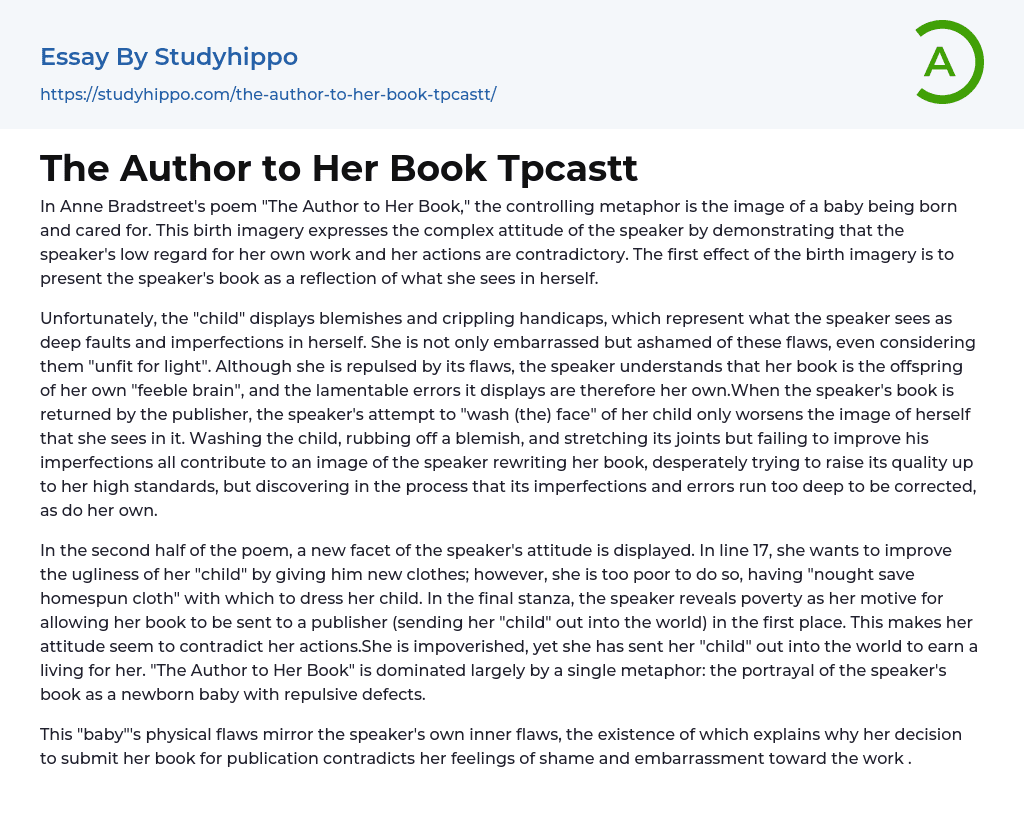In Anne Bradstreet's poem "The Author to Her Book," the controlling metaphor is the image of a baby being born and cared for. This birth imagery expresses the complex attitude of the speaker by demonstrating that the speaker's low regard for her own work and her actions are contradictory. The first effect of the birth imagery is to present the speaker's book as a reflection of what she sees in herself.
Unfortunately, the "child" displays blemishes and crippling handicaps, which represent what the speaker sees as deep faults and imperfections in herself. She is not only embarrassed but ashamed of these flaws, even considering them "unfit for light". Although she is repulsed by its flaws, the speaker understands that her book is the offspring of her own "feeble brain", and the lamentable errors
...it displays are therefore her own.When the speaker's book is returned by the publisher, the speaker's attempt to "wash (the) face" of her child only worsens the image of herself that she sees in it. Washing the child, rubbing off a blemish, and stretching its joints but failing to improve his imperfections all contribute to an image of the speaker rewriting her book, desperately trying to raise its quality up to her high standards, but discovering in the process that its imperfections and errors run too deep to be corrected, as do her own.
In the second half of the poem, a new facet of the speaker's attitude is displayed. In line 17, she wants to improve the ugliness of her "child" by giving him new clothes; however, she is too poor to do so, having "nought save homespun cloth" with which to dres
her child. In the final stanza, the speaker reveals poverty as her motive for allowing her book to be sent to a publisher (sending her "child" out into the world) in the first place. This makes her attitude seem to contradict her actions.She is impoverished, yet she has sent her "child" out into the world to earn a living for her. "The Author to Her Book" is dominated largely by a single metaphor: the portrayal of the speaker's book as a newborn baby with repulsive defects.
This "baby"'s physical flaws mirror the speaker's own inner flaws, the existence of which explains why her decision to submit her book for publication contradicts her feelings of shame and embarrassment toward the work .
- Boo Radley essays
- Genesis essays
- Richard iii essays
- Alice in Wonderland essays
- On the road essays
- Ozymandias essays
- The Nightingale essays
- Holden Caulfield essays
- Animal Farm essays
- 1984 essays
- A Hanging essays
- Shooting An Elephant essays
- A Tale Of Two Cities essays
- Adventures Of Huckleberry Finn essays
- Arthur Conan Doyle essays
- Brave New World essays
- Characters In Hamlet essays
- Characters In Romeo And Juliet essays
- Desdemona essays
- Diary Of A Wimpy Kid essays
- First-Person Narrative essays
- Frankenstein essays
- Heart Of Darkness essays
- Jane Eyre essays
- Jay Gatsby essays
- King Duncan essays
- Librarian essays
- Little Red Riding Hood essays
- Lord Of The Flies essays
- Silas Marner essays
- The Cask Of Amontillado essays
- The Catcher In The Rye essays
- The Crucible essays
- The Handmaid's Tale essays
- The Reader essays
- Virgil essays
- Wuthering Heights essays
- Candide essays
- Castle essays
- J. D. Salinger essays
- Ulysses essays
- Ethan Frome essays
- In Cold Blood essays
- Outliers essays
- Tuesdays With Morrie essays
- The Art of War essays
- Wife of Bath essays
- Huckleberry Finn essays
- The Lady With The Dog essays
- Great Expectations essays




